Copyright as an Engine of Free Expression: A Critical Examination
VerifiedAdded on 2023/04/24
|10
|3149
|403
Essay
AI Summary
This essay critically examines the assertion that copyright serves as an engine of free expression. It begins by defining copyright and its historical context, then explores its role in incentivizing creativity by providing authors with exclusive rights to their work for a limited time. The essay acknowledges the counter-arguments, discussing how copyright can also be perceived as an obstacle due to restrictions on use and the potential for hindering the free flow of information. It delves into the discourses surrounding copyright, particularly in the digital age, and analyzes the social, cultural, and ethical issues affected by copyright laws, including aspects of control, accountability, and access to cultural heritage. The essay utilizes academic sources to support its arguments, evaluates various viewpoints, and ultimately provides a comprehensive analysis of the complex relationship between copyright and free expression, offering insights into its multifaceted impact on creative works and society.
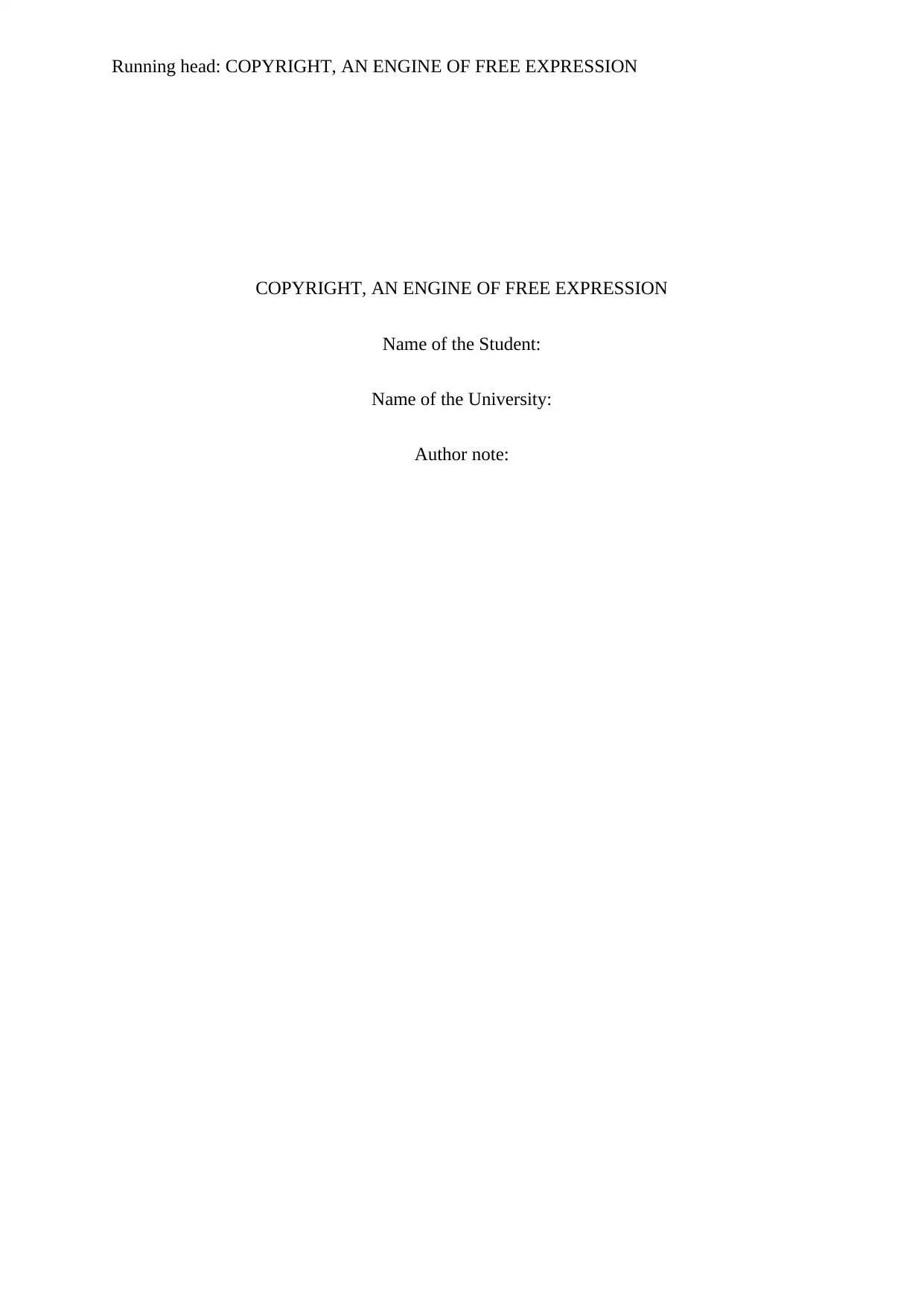
Running head: COPYRIGHT, AN ENGINE OF FREE EXPRESSION
COPYRIGHT, AN ENGINE OF FREE EXPRESSION
Name of the Student:
Name of the University:
Author note:
COPYRIGHT, AN ENGINE OF FREE EXPRESSION
Name of the Student:
Name of the University:
Author note:
Paraphrase This Document
Need a fresh take? Get an instant paraphrase of this document with our AI Paraphraser
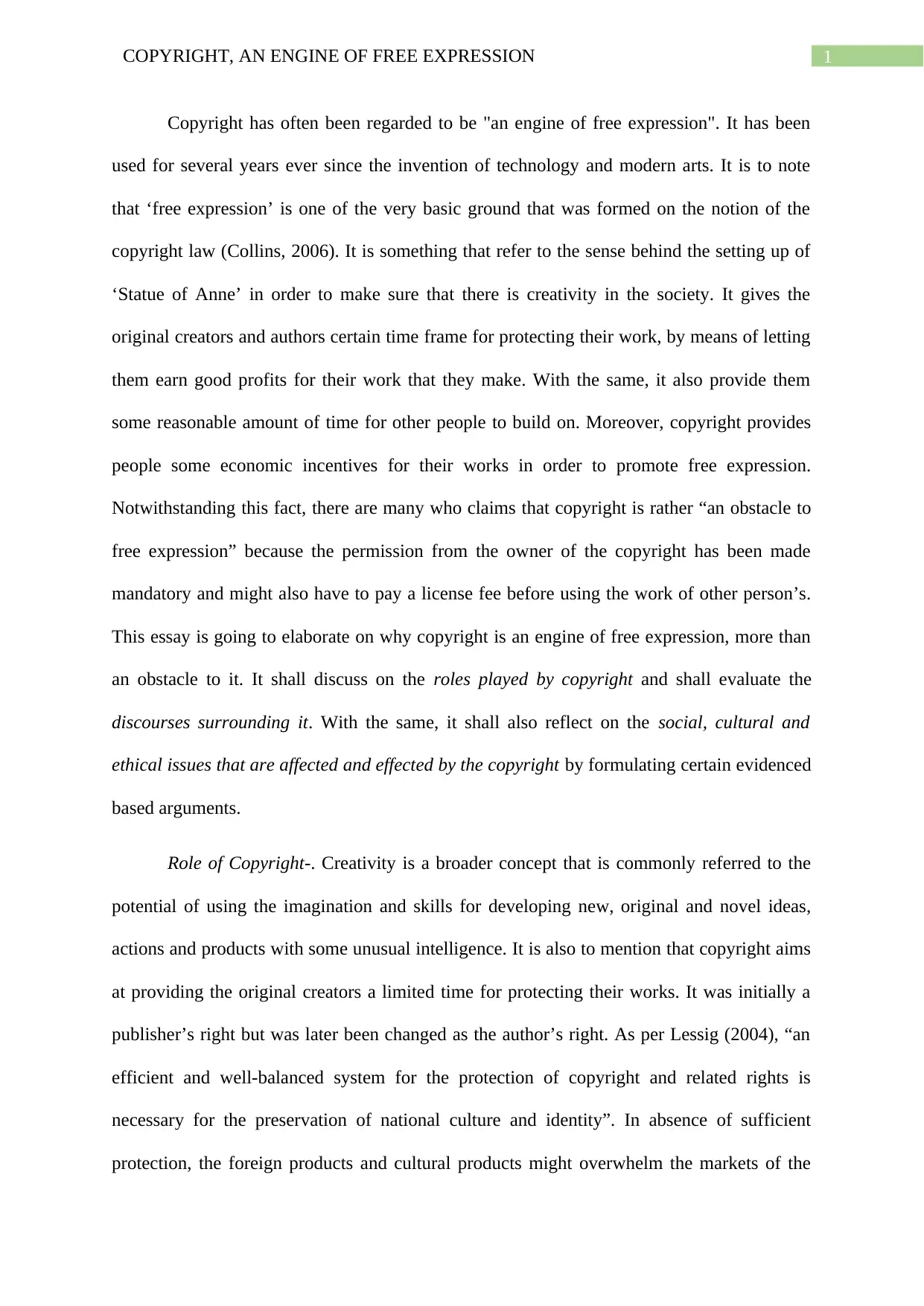
1COPYRIGHT, AN ENGINE OF FREE EXPRESSION
Copyright has often been regarded to be "an engine of free expression". It has been
used for several years ever since the invention of technology and modern arts. It is to note
that ‘free expression’ is one of the very basic ground that was formed on the notion of the
copyright law (Collins, 2006). It is something that refer to the sense behind the setting up of
‘Statue of Anne’ in order to make sure that there is creativity in the society. It gives the
original creators and authors certain time frame for protecting their work, by means of letting
them earn good profits for their work that they make. With the same, it also provide them
some reasonable amount of time for other people to build on. Moreover, copyright provides
people some economic incentives for their works in order to promote free expression.
Notwithstanding this fact, there are many who claims that copyright is rather “an obstacle to
free expression” because the permission from the owner of the copyright has been made
mandatory and might also have to pay a license fee before using the work of other person’s.
This essay is going to elaborate on why copyright is an engine of free expression, more than
an obstacle to it. It shall discuss on the roles played by copyright and shall evaluate the
discourses surrounding it. With the same, it shall also reflect on the social, cultural and
ethical issues that are affected and effected by the copyright by formulating certain evidenced
based arguments.
Role of Copyright-. Creativity is a broader concept that is commonly referred to the
potential of using the imagination and skills for developing new, original and novel ideas,
actions and products with some unusual intelligence. It is also to mention that copyright aims
at providing the original creators a limited time for protecting their works. It was initially a
publisher’s right but was later been changed as the author’s right. As per Lessig (2004), “an
efficient and well-balanced system for the protection of copyright and related rights is
necessary for the preservation of national culture and identity”. In absence of sufficient
protection, the foreign products and cultural products might overwhelm the markets of the
Copyright has often been regarded to be "an engine of free expression". It has been
used for several years ever since the invention of technology and modern arts. It is to note
that ‘free expression’ is one of the very basic ground that was formed on the notion of the
copyright law (Collins, 2006). It is something that refer to the sense behind the setting up of
‘Statue of Anne’ in order to make sure that there is creativity in the society. It gives the
original creators and authors certain time frame for protecting their work, by means of letting
them earn good profits for their work that they make. With the same, it also provide them
some reasonable amount of time for other people to build on. Moreover, copyright provides
people some economic incentives for their works in order to promote free expression.
Notwithstanding this fact, there are many who claims that copyright is rather “an obstacle to
free expression” because the permission from the owner of the copyright has been made
mandatory and might also have to pay a license fee before using the work of other person’s.
This essay is going to elaborate on why copyright is an engine of free expression, more than
an obstacle to it. It shall discuss on the roles played by copyright and shall evaluate the
discourses surrounding it. With the same, it shall also reflect on the social, cultural and
ethical issues that are affected and effected by the copyright by formulating certain evidenced
based arguments.
Role of Copyright-. Creativity is a broader concept that is commonly referred to the
potential of using the imagination and skills for developing new, original and novel ideas,
actions and products with some unusual intelligence. It is also to mention that copyright aims
at providing the original creators a limited time for protecting their works. It was initially a
publisher’s right but was later been changed as the author’s right. As per Lessig (2004), “an
efficient and well-balanced system for the protection of copyright and related rights is
necessary for the preservation of national culture and identity”. In absence of sufficient
protection, the foreign products and cultural products might overwhelm the markets of the
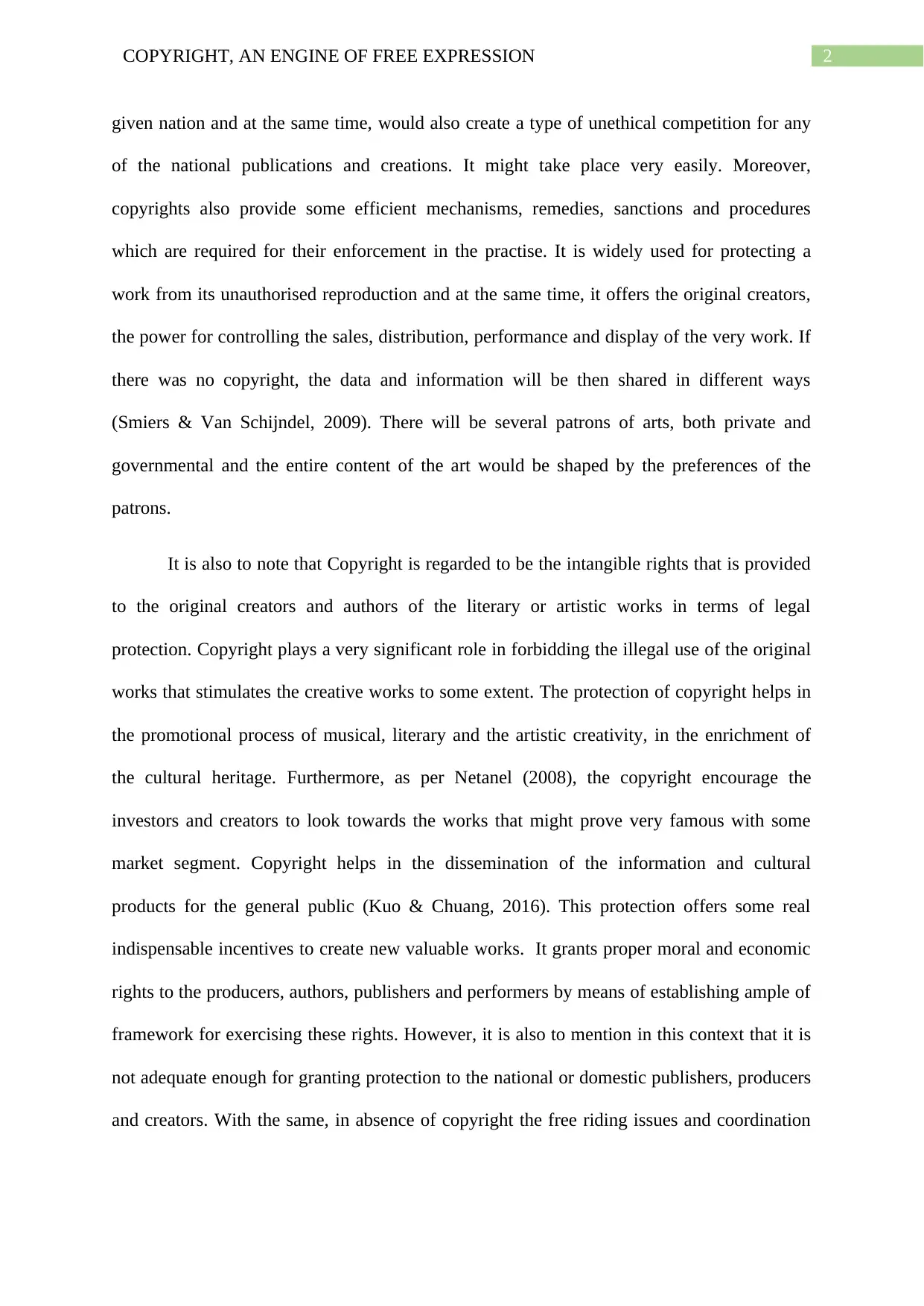
2COPYRIGHT, AN ENGINE OF FREE EXPRESSION
given nation and at the same time, would also create a type of unethical competition for any
of the national publications and creations. It might take place very easily. Moreover,
copyrights also provide some efficient mechanisms, remedies, sanctions and procedures
which are required for their enforcement in the practise. It is widely used for protecting a
work from its unauthorised reproduction and at the same time, it offers the original creators,
the power for controlling the sales, distribution, performance and display of the very work. If
there was no copyright, the data and information will be then shared in different ways
(Smiers & Van Schijndel, 2009). There will be several patrons of arts, both private and
governmental and the entire content of the art would be shaped by the preferences of the
patrons.
It is also to note that Copyright is regarded to be the intangible rights that is provided
to the original creators and authors of the literary or artistic works in terms of legal
protection. Copyright plays a very significant role in forbidding the illegal use of the original
works that stimulates the creative works to some extent. The protection of copyright helps in
the promotional process of musical, literary and the artistic creativity, in the enrichment of
the cultural heritage. Furthermore, as per Netanel (2008), the copyright encourage the
investors and creators to look towards the works that might prove very famous with some
market segment. Copyright helps in the dissemination of the information and cultural
products for the general public (Kuo & Chuang, 2016). This protection offers some real
indispensable incentives to create new valuable works. It grants proper moral and economic
rights to the producers, authors, publishers and performers by means of establishing ample of
framework for exercising these rights. However, it is also to mention in this context that it is
not adequate enough for granting protection to the national or domestic publishers, producers
and creators. With the same, in absence of copyright the free riding issues and coordination
given nation and at the same time, would also create a type of unethical competition for any
of the national publications and creations. It might take place very easily. Moreover,
copyrights also provide some efficient mechanisms, remedies, sanctions and procedures
which are required for their enforcement in the practise. It is widely used for protecting a
work from its unauthorised reproduction and at the same time, it offers the original creators,
the power for controlling the sales, distribution, performance and display of the very work. If
there was no copyright, the data and information will be then shared in different ways
(Smiers & Van Schijndel, 2009). There will be several patrons of arts, both private and
governmental and the entire content of the art would be shaped by the preferences of the
patrons.
It is also to note that Copyright is regarded to be the intangible rights that is provided
to the original creators and authors of the literary or artistic works in terms of legal
protection. Copyright plays a very significant role in forbidding the illegal use of the original
works that stimulates the creative works to some extent. The protection of copyright helps in
the promotional process of musical, literary and the artistic creativity, in the enrichment of
the cultural heritage. Furthermore, as per Netanel (2008), the copyright encourage the
investors and creators to look towards the works that might prove very famous with some
market segment. Copyright helps in the dissemination of the information and cultural
products for the general public (Kuo & Chuang, 2016). This protection offers some real
indispensable incentives to create new valuable works. It grants proper moral and economic
rights to the producers, authors, publishers and performers by means of establishing ample of
framework for exercising these rights. However, it is also to mention in this context that it is
not adequate enough for granting protection to the national or domestic publishers, producers
and creators. With the same, in absence of copyright the free riding issues and coordination
⊘ This is a preview!⊘
Do you want full access?
Subscribe today to unlock all pages.

Trusted by 1+ million students worldwide
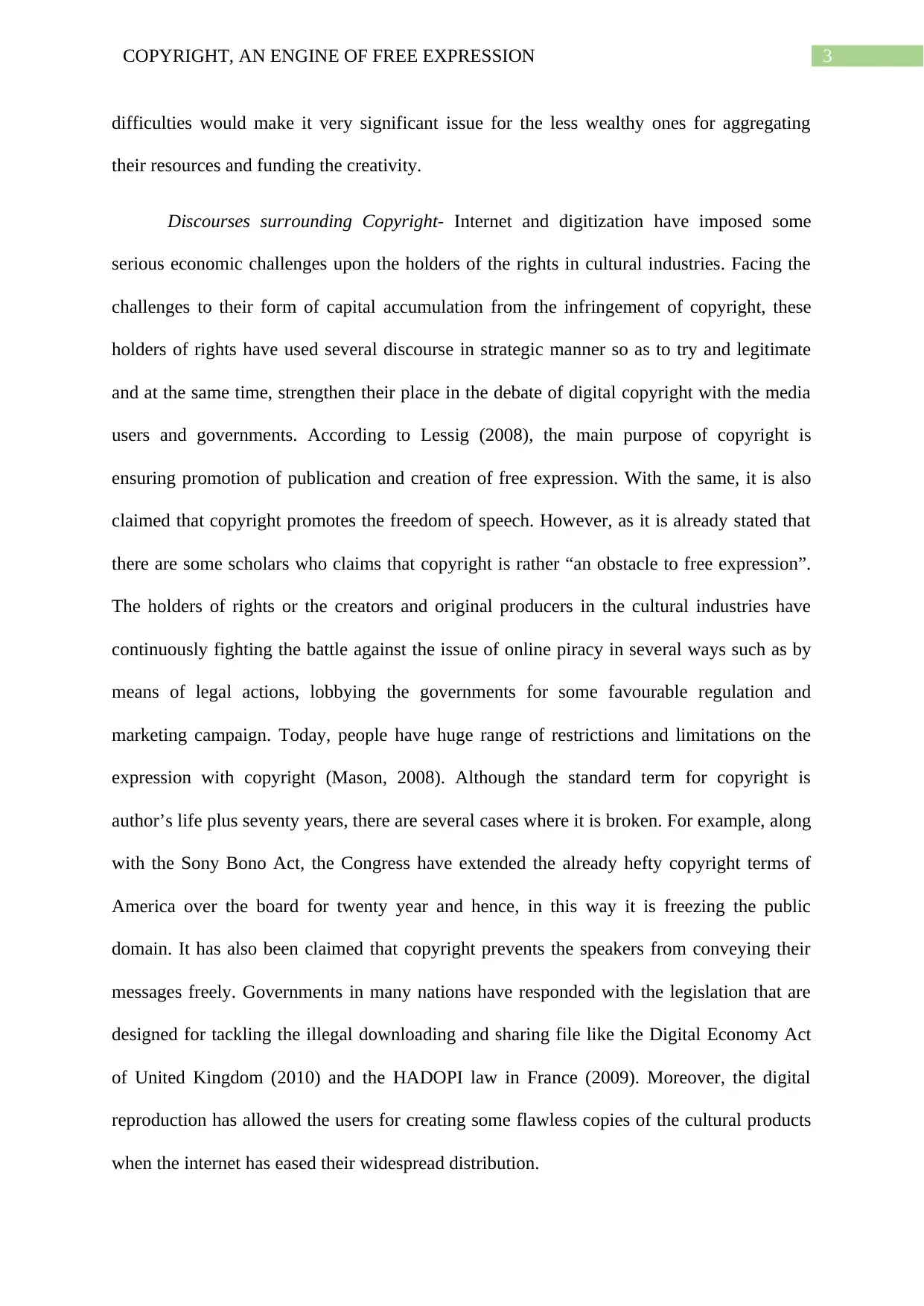
3COPYRIGHT, AN ENGINE OF FREE EXPRESSION
difficulties would make it very significant issue for the less wealthy ones for aggregating
their resources and funding the creativity.
Discourses surrounding Copyright- Internet and digitization have imposed some
serious economic challenges upon the holders of the rights in cultural industries. Facing the
challenges to their form of capital accumulation from the infringement of copyright, these
holders of rights have used several discourse in strategic manner so as to try and legitimate
and at the same time, strengthen their place in the debate of digital copyright with the media
users and governments. According to Lessig (2008), the main purpose of copyright is
ensuring promotion of publication and creation of free expression. With the same, it is also
claimed that copyright promotes the freedom of speech. However, as it is already stated that
there are some scholars who claims that copyright is rather “an obstacle to free expression”.
The holders of rights or the creators and original producers in the cultural industries have
continuously fighting the battle against the issue of online piracy in several ways such as by
means of legal actions, lobbying the governments for some favourable regulation and
marketing campaign. Today, people have huge range of restrictions and limitations on the
expression with copyright (Mason, 2008). Although the standard term for copyright is
author’s life plus seventy years, there are several cases where it is broken. For example, along
with the Sony Bono Act, the Congress have extended the already hefty copyright terms of
America over the board for twenty year and hence, in this way it is freezing the public
domain. It has also been claimed that copyright prevents the speakers from conveying their
messages freely. Governments in many nations have responded with the legislation that are
designed for tackling the illegal downloading and sharing file like the Digital Economy Act
of United Kingdom (2010) and the HADOPI law in France (2009). Moreover, the digital
reproduction has allowed the users for creating some flawless copies of the cultural products
when the internet has eased their widespread distribution.
difficulties would make it very significant issue for the less wealthy ones for aggregating
their resources and funding the creativity.
Discourses surrounding Copyright- Internet and digitization have imposed some
serious economic challenges upon the holders of the rights in cultural industries. Facing the
challenges to their form of capital accumulation from the infringement of copyright, these
holders of rights have used several discourse in strategic manner so as to try and legitimate
and at the same time, strengthen their place in the debate of digital copyright with the media
users and governments. According to Lessig (2008), the main purpose of copyright is
ensuring promotion of publication and creation of free expression. With the same, it is also
claimed that copyright promotes the freedom of speech. However, as it is already stated that
there are some scholars who claims that copyright is rather “an obstacle to free expression”.
The holders of rights or the creators and original producers in the cultural industries have
continuously fighting the battle against the issue of online piracy in several ways such as by
means of legal actions, lobbying the governments for some favourable regulation and
marketing campaign. Today, people have huge range of restrictions and limitations on the
expression with copyright (Mason, 2008). Although the standard term for copyright is
author’s life plus seventy years, there are several cases where it is broken. For example, along
with the Sony Bono Act, the Congress have extended the already hefty copyright terms of
America over the board for twenty year and hence, in this way it is freezing the public
domain. It has also been claimed that copyright prevents the speakers from conveying their
messages freely. Governments in many nations have responded with the legislation that are
designed for tackling the illegal downloading and sharing file like the Digital Economy Act
of United Kingdom (2010) and the HADOPI law in France (2009). Moreover, the digital
reproduction has allowed the users for creating some flawless copies of the cultural products
when the internet has eased their widespread distribution.
Paraphrase This Document
Need a fresh take? Get an instant paraphrase of this document with our AI Paraphraser
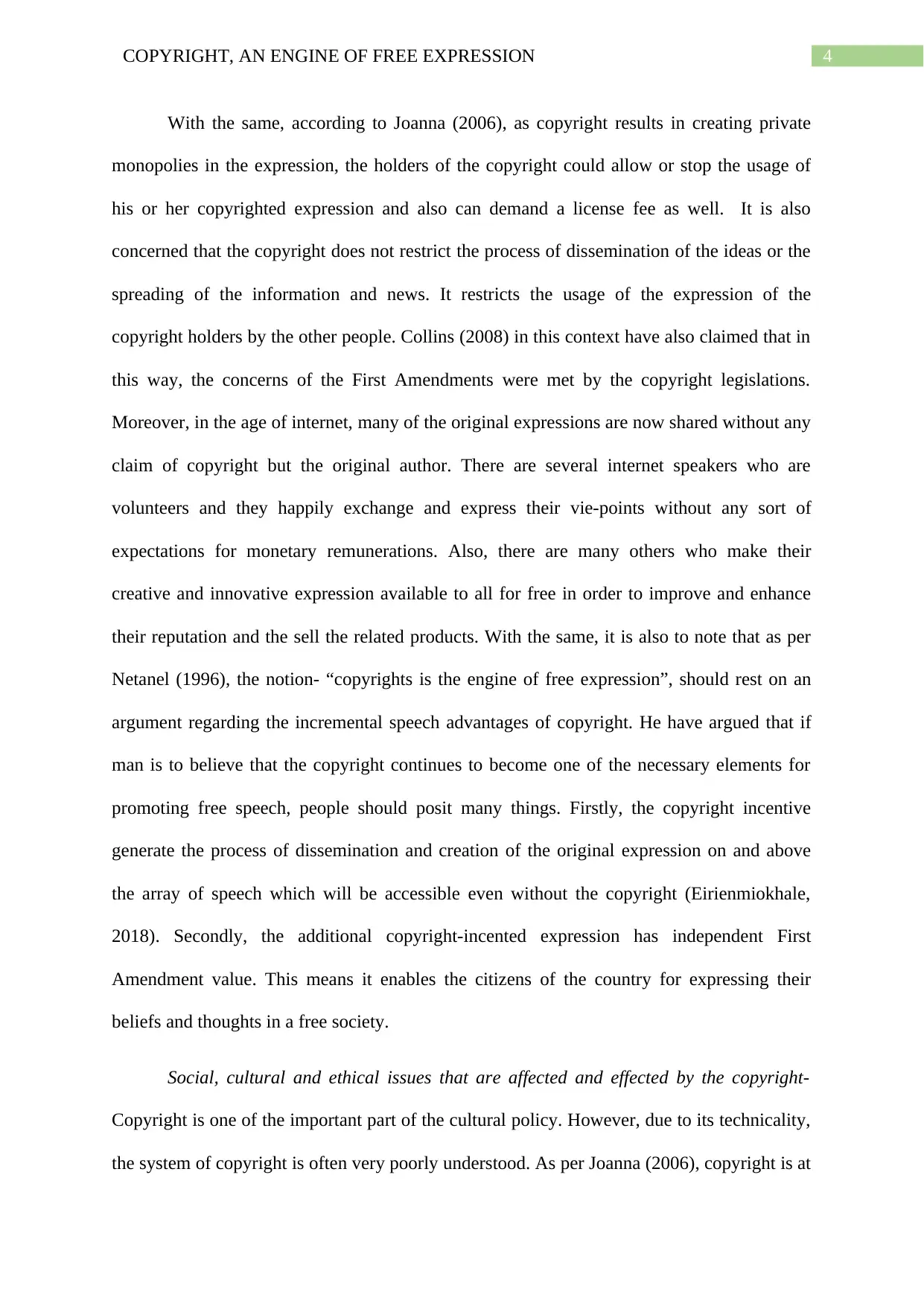
4COPYRIGHT, AN ENGINE OF FREE EXPRESSION
With the same, according to Joanna (2006), as copyright results in creating private
monopolies in the expression, the holders of the copyright could allow or stop the usage of
his or her copyrighted expression and also can demand a license fee as well. It is also
concerned that the copyright does not restrict the process of dissemination of the ideas or the
spreading of the information and news. It restricts the usage of the expression of the
copyright holders by the other people. Collins (2008) in this context have also claimed that in
this way, the concerns of the First Amendments were met by the copyright legislations.
Moreover, in the age of internet, many of the original expressions are now shared without any
claim of copyright but the original author. There are several internet speakers who are
volunteers and they happily exchange and express their vie-points without any sort of
expectations for monetary remunerations. Also, there are many others who make their
creative and innovative expression available to all for free in order to improve and enhance
their reputation and the sell the related products. With the same, it is also to note that as per
Netanel (1996), the notion- “copyrights is the engine of free expression”, should rest on an
argument regarding the incremental speech advantages of copyright. He have argued that if
man is to believe that the copyright continues to become one of the necessary elements for
promoting free speech, people should posit many things. Firstly, the copyright incentive
generate the process of dissemination and creation of the original expression on and above
the array of speech which will be accessible even without the copyright (Eirienmiokhale,
2018). Secondly, the additional copyright-incented expression has independent First
Amendment value. This means it enables the citizens of the country for expressing their
beliefs and thoughts in a free society.
Social, cultural and ethical issues that are affected and effected by the copyright-
Copyright is one of the important part of the cultural policy. However, due to its technicality,
the system of copyright is often very poorly understood. As per Joanna (2006), copyright is at
With the same, according to Joanna (2006), as copyright results in creating private
monopolies in the expression, the holders of the copyright could allow or stop the usage of
his or her copyrighted expression and also can demand a license fee as well. It is also
concerned that the copyright does not restrict the process of dissemination of the ideas or the
spreading of the information and news. It restricts the usage of the expression of the
copyright holders by the other people. Collins (2008) in this context have also claimed that in
this way, the concerns of the First Amendments were met by the copyright legislations.
Moreover, in the age of internet, many of the original expressions are now shared without any
claim of copyright but the original author. There are several internet speakers who are
volunteers and they happily exchange and express their vie-points without any sort of
expectations for monetary remunerations. Also, there are many others who make their
creative and innovative expression available to all for free in order to improve and enhance
their reputation and the sell the related products. With the same, it is also to note that as per
Netanel (1996), the notion- “copyrights is the engine of free expression”, should rest on an
argument regarding the incremental speech advantages of copyright. He have argued that if
man is to believe that the copyright continues to become one of the necessary elements for
promoting free speech, people should posit many things. Firstly, the copyright incentive
generate the process of dissemination and creation of the original expression on and above
the array of speech which will be accessible even without the copyright (Eirienmiokhale,
2018). Secondly, the additional copyright-incented expression has independent First
Amendment value. This means it enables the citizens of the country for expressing their
beliefs and thoughts in a free society.
Social, cultural and ethical issues that are affected and effected by the copyright-
Copyright is one of the important part of the cultural policy. However, due to its technicality,
the system of copyright is often very poorly understood. As per Joanna (2006), copyright is at
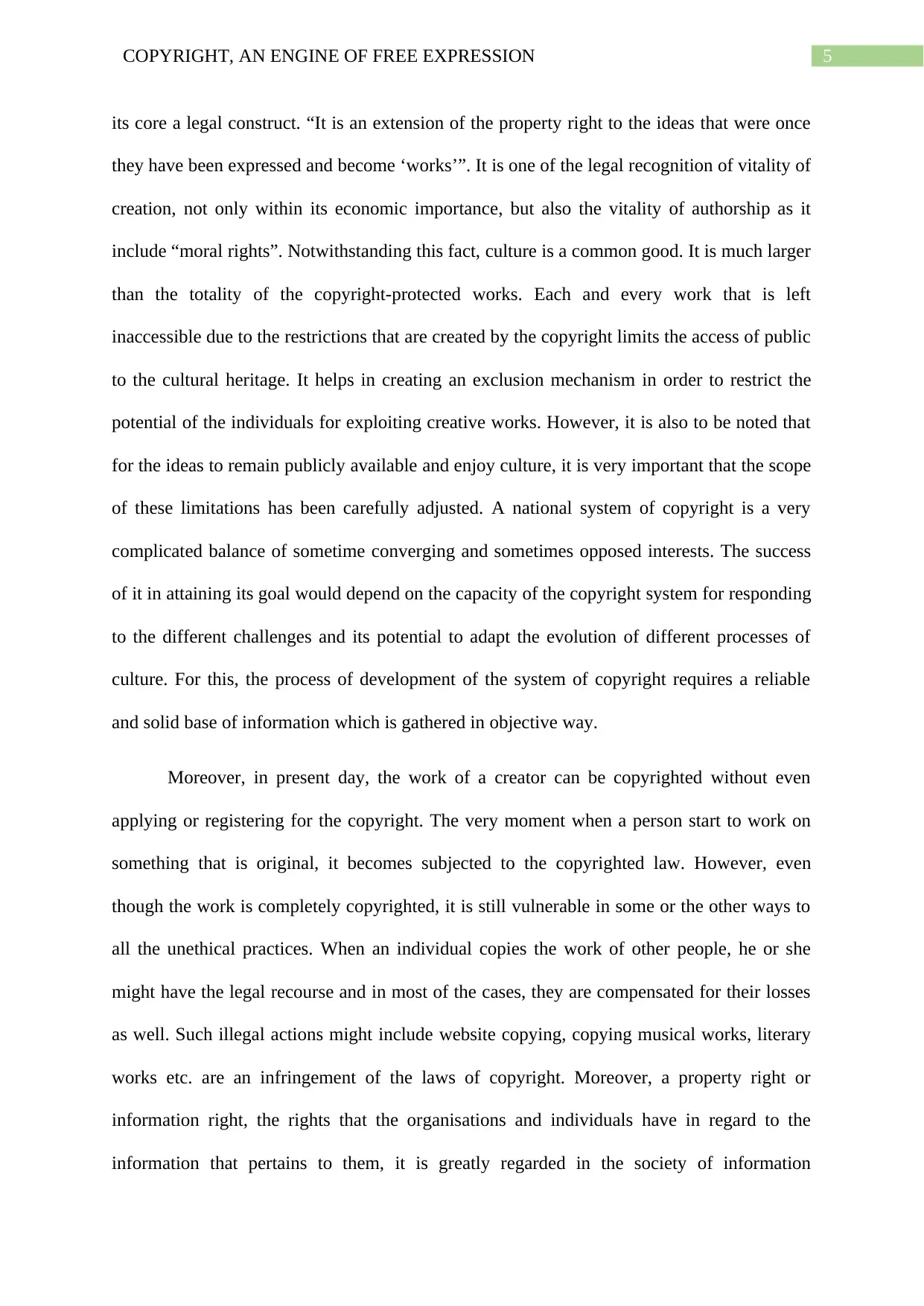
5COPYRIGHT, AN ENGINE OF FREE EXPRESSION
its core a legal construct. “It is an extension of the property right to the ideas that were once
they have been expressed and become ‘works’”. It is one of the legal recognition of vitality of
creation, not only within its economic importance, but also the vitality of authorship as it
include “moral rights”. Notwithstanding this fact, culture is a common good. It is much larger
than the totality of the copyright-protected works. Each and every work that is left
inaccessible due to the restrictions that are created by the copyright limits the access of public
to the cultural heritage. It helps in creating an exclusion mechanism in order to restrict the
potential of the individuals for exploiting creative works. However, it is also to be noted that
for the ideas to remain publicly available and enjoy culture, it is very important that the scope
of these limitations has been carefully adjusted. A national system of copyright is a very
complicated balance of sometime converging and sometimes opposed interests. The success
of it in attaining its goal would depend on the capacity of the copyright system for responding
to the different challenges and its potential to adapt the evolution of different processes of
culture. For this, the process of development of the system of copyright requires a reliable
and solid base of information which is gathered in objective way.
Moreover, in present day, the work of a creator can be copyrighted without even
applying or registering for the copyright. The very moment when a person start to work on
something that is original, it becomes subjected to the copyrighted law. However, even
though the work is completely copyrighted, it is still vulnerable in some or the other ways to
all the unethical practices. When an individual copies the work of other people, he or she
might have the legal recourse and in most of the cases, they are compensated for their losses
as well. Such illegal actions might include website copying, copying musical works, literary
works etc. are an infringement of the laws of copyright. Moreover, a property right or
information right, the rights that the organisations and individuals have in regard to the
information that pertains to them, it is greatly regarded in the society of information
its core a legal construct. “It is an extension of the property right to the ideas that were once
they have been expressed and become ‘works’”. It is one of the legal recognition of vitality of
creation, not only within its economic importance, but also the vitality of authorship as it
include “moral rights”. Notwithstanding this fact, culture is a common good. It is much larger
than the totality of the copyright-protected works. Each and every work that is left
inaccessible due to the restrictions that are created by the copyright limits the access of public
to the cultural heritage. It helps in creating an exclusion mechanism in order to restrict the
potential of the individuals for exploiting creative works. However, it is also to be noted that
for the ideas to remain publicly available and enjoy culture, it is very important that the scope
of these limitations has been carefully adjusted. A national system of copyright is a very
complicated balance of sometime converging and sometimes opposed interests. The success
of it in attaining its goal would depend on the capacity of the copyright system for responding
to the different challenges and its potential to adapt the evolution of different processes of
culture. For this, the process of development of the system of copyright requires a reliable
and solid base of information which is gathered in objective way.
Moreover, in present day, the work of a creator can be copyrighted without even
applying or registering for the copyright. The very moment when a person start to work on
something that is original, it becomes subjected to the copyrighted law. However, even
though the work is completely copyrighted, it is still vulnerable in some or the other ways to
all the unethical practices. When an individual copies the work of other people, he or she
might have the legal recourse and in most of the cases, they are compensated for their losses
as well. Such illegal actions might include website copying, copying musical works, literary
works etc. are an infringement of the laws of copyright. Moreover, a property right or
information right, the rights that the organisations and individuals have in regard to the
information that pertains to them, it is greatly regarded in the society of information
⊘ This is a preview!⊘
Do you want full access?
Subscribe today to unlock all pages.

Trusted by 1+ million students worldwide
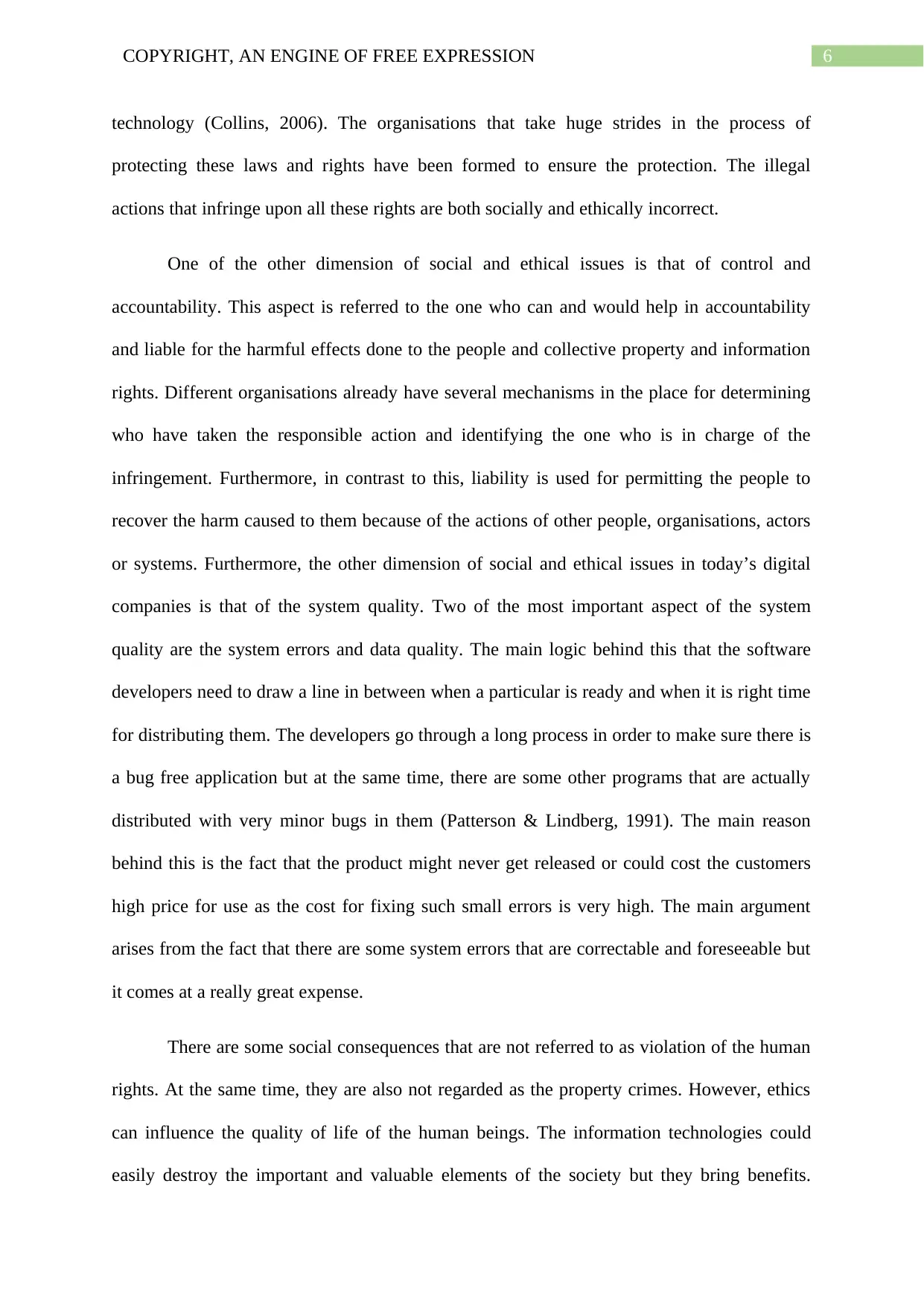
6COPYRIGHT, AN ENGINE OF FREE EXPRESSION
technology (Collins, 2006). The organisations that take huge strides in the process of
protecting these laws and rights have been formed to ensure the protection. The illegal
actions that infringe upon all these rights are both socially and ethically incorrect.
One of the other dimension of social and ethical issues is that of control and
accountability. This aspect is referred to the one who can and would help in accountability
and liable for the harmful effects done to the people and collective property and information
rights. Different organisations already have several mechanisms in the place for determining
who have taken the responsible action and identifying the one who is in charge of the
infringement. Furthermore, in contrast to this, liability is used for permitting the people to
recover the harm caused to them because of the actions of other people, organisations, actors
or systems. Furthermore, the other dimension of social and ethical issues in today’s digital
companies is that of the system quality. Two of the most important aspect of the system
quality are the system errors and data quality. The main logic behind this that the software
developers need to draw a line in between when a particular is ready and when it is right time
for distributing them. The developers go through a long process in order to make sure there is
a bug free application but at the same time, there are some other programs that are actually
distributed with very minor bugs in them (Patterson & Lindberg, 1991). The main reason
behind this is the fact that the product might never get released or could cost the customers
high price for use as the cost for fixing such small errors is very high. The main argument
arises from the fact that there are some system errors that are correctable and foreseeable but
it comes at a really great expense.
There are some social consequences that are not referred to as violation of the human
rights. At the same time, they are also not regarded as the property crimes. However, ethics
can influence the quality of life of the human beings. The information technologies could
easily destroy the important and valuable elements of the society but they bring benefits.
technology (Collins, 2006). The organisations that take huge strides in the process of
protecting these laws and rights have been formed to ensure the protection. The illegal
actions that infringe upon all these rights are both socially and ethically incorrect.
One of the other dimension of social and ethical issues is that of control and
accountability. This aspect is referred to the one who can and would help in accountability
and liable for the harmful effects done to the people and collective property and information
rights. Different organisations already have several mechanisms in the place for determining
who have taken the responsible action and identifying the one who is in charge of the
infringement. Furthermore, in contrast to this, liability is used for permitting the people to
recover the harm caused to them because of the actions of other people, organisations, actors
or systems. Furthermore, the other dimension of social and ethical issues in today’s digital
companies is that of the system quality. Two of the most important aspect of the system
quality are the system errors and data quality. The main logic behind this that the software
developers need to draw a line in between when a particular is ready and when it is right time
for distributing them. The developers go through a long process in order to make sure there is
a bug free application but at the same time, there are some other programs that are actually
distributed with very minor bugs in them (Patterson & Lindberg, 1991). The main reason
behind this is the fact that the product might never get released or could cost the customers
high price for use as the cost for fixing such small errors is very high. The main argument
arises from the fact that there are some system errors that are correctable and foreseeable but
it comes at a really great expense.
There are some social consequences that are not referred to as violation of the human
rights. At the same time, they are also not regarded as the property crimes. However, ethics
can influence the quality of life of the human beings. The information technologies could
easily destroy the important and valuable elements of the society but they bring benefits.
Paraphrase This Document
Need a fresh take? Get an instant paraphrase of this document with our AI Paraphraser
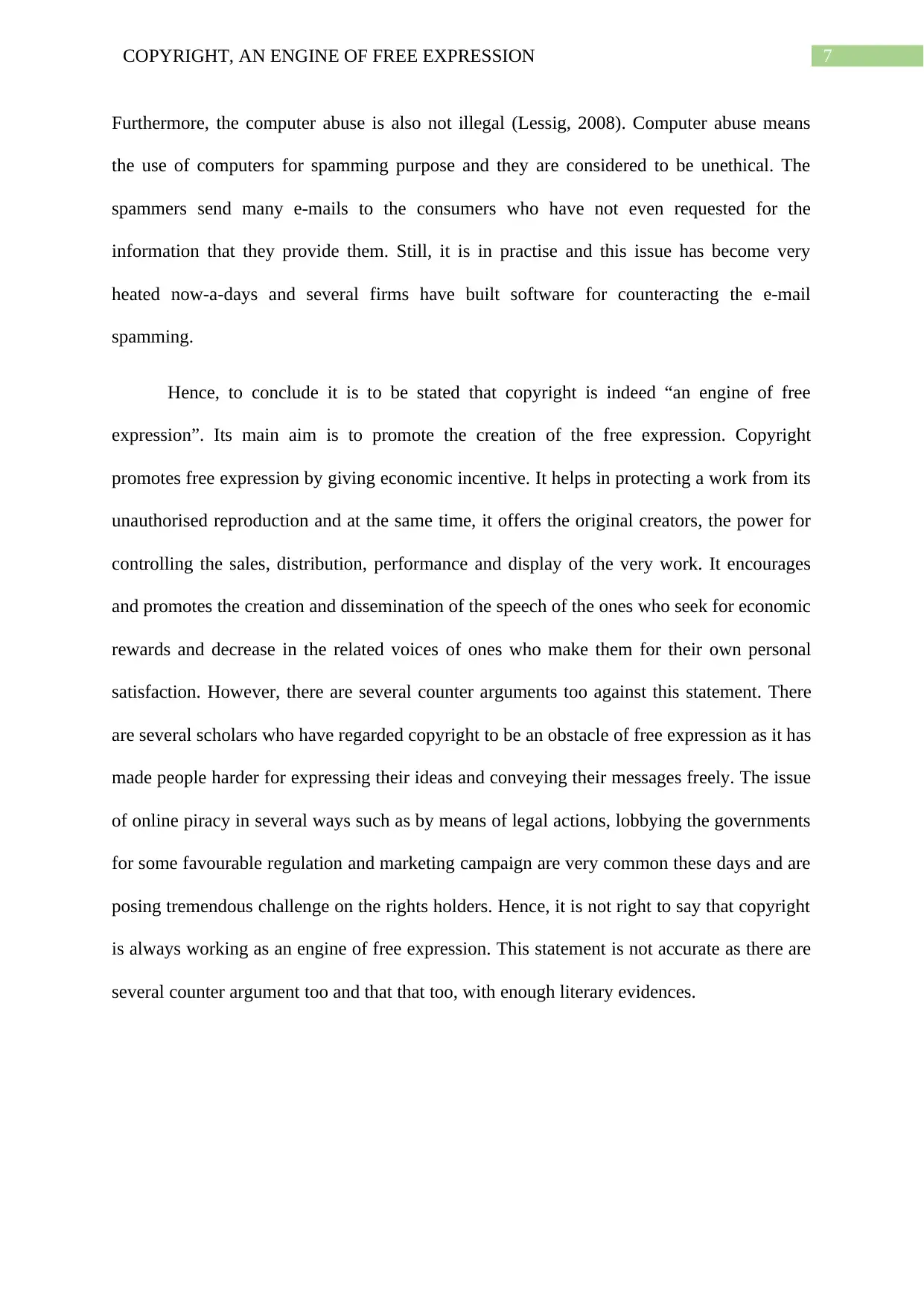
7COPYRIGHT, AN ENGINE OF FREE EXPRESSION
Furthermore, the computer abuse is also not illegal (Lessig, 2008). Computer abuse means
the use of computers for spamming purpose and they are considered to be unethical. The
spammers send many e-mails to the consumers who have not even requested for the
information that they provide them. Still, it is in practise and this issue has become very
heated now-a-days and several firms have built software for counteracting the e-mail
spamming.
Hence, to conclude it is to be stated that copyright is indeed “an engine of free
expression”. Its main aim is to promote the creation of the free expression. Copyright
promotes free expression by giving economic incentive. It helps in protecting a work from its
unauthorised reproduction and at the same time, it offers the original creators, the power for
controlling the sales, distribution, performance and display of the very work. It encourages
and promotes the creation and dissemination of the speech of the ones who seek for economic
rewards and decrease in the related voices of ones who make them for their own personal
satisfaction. However, there are several counter arguments too against this statement. There
are several scholars who have regarded copyright to be an obstacle of free expression as it has
made people harder for expressing their ideas and conveying their messages freely. The issue
of online piracy in several ways such as by means of legal actions, lobbying the governments
for some favourable regulation and marketing campaign are very common these days and are
posing tremendous challenge on the rights holders. Hence, it is not right to say that copyright
is always working as an engine of free expression. This statement is not accurate as there are
several counter argument too and that that too, with enough literary evidences.
Furthermore, the computer abuse is also not illegal (Lessig, 2008). Computer abuse means
the use of computers for spamming purpose and they are considered to be unethical. The
spammers send many e-mails to the consumers who have not even requested for the
information that they provide them. Still, it is in practise and this issue has become very
heated now-a-days and several firms have built software for counteracting the e-mail
spamming.
Hence, to conclude it is to be stated that copyright is indeed “an engine of free
expression”. Its main aim is to promote the creation of the free expression. Copyright
promotes free expression by giving economic incentive. It helps in protecting a work from its
unauthorised reproduction and at the same time, it offers the original creators, the power for
controlling the sales, distribution, performance and display of the very work. It encourages
and promotes the creation and dissemination of the speech of the ones who seek for economic
rewards and decrease in the related voices of ones who make them for their own personal
satisfaction. However, there are several counter arguments too against this statement. There
are several scholars who have regarded copyright to be an obstacle of free expression as it has
made people harder for expressing their ideas and conveying their messages freely. The issue
of online piracy in several ways such as by means of legal actions, lobbying the governments
for some favourable regulation and marketing campaign are very common these days and are
posing tremendous challenge on the rights holders. Hence, it is not right to say that copyright
is always working as an engine of free expression. This statement is not accurate as there are
several counter argument too and that that too, with enough literary evidences.
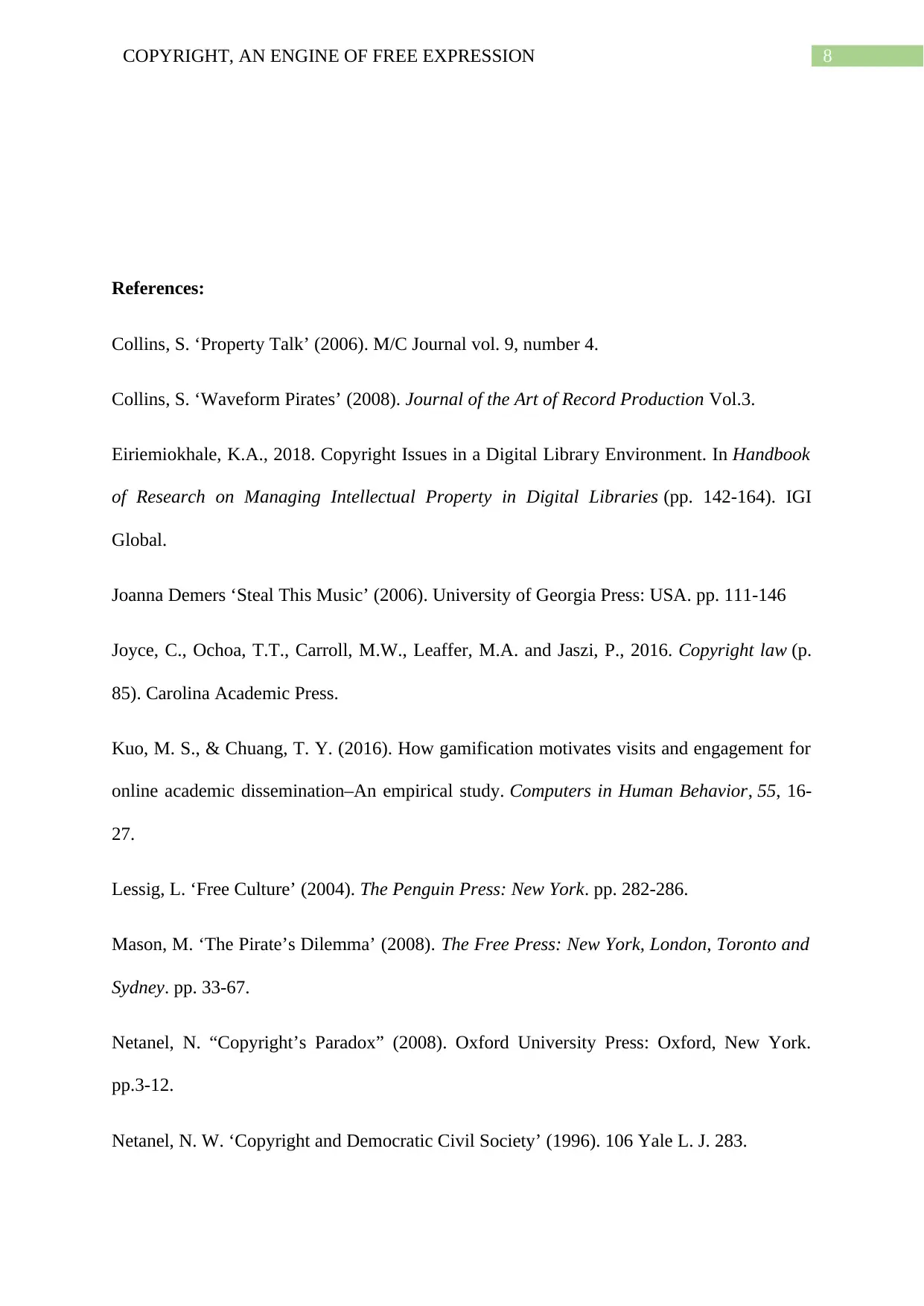
8COPYRIGHT, AN ENGINE OF FREE EXPRESSION
References:
Collins, S. ‘Property Talk’ (2006). M/C Journal vol. 9, number 4.
Collins, S. ‘Waveform Pirates’ (2008). Journal of the Art of Record Production Vol.3.
Eiriemiokhale, K.A., 2018. Copyright Issues in a Digital Library Environment. In Handbook
of Research on Managing Intellectual Property in Digital Libraries (pp. 142-164). IGI
Global.
Joanna Demers ‘Steal This Music’ (2006). University of Georgia Press: USA. pp. 111-146
Joyce, C., Ochoa, T.T., Carroll, M.W., Leaffer, M.A. and Jaszi, P., 2016. Copyright law (p.
85). Carolina Academic Press.
Kuo, M. S., & Chuang, T. Y. (2016). How gamification motivates visits and engagement for
online academic dissemination–An empirical study. Computers in Human Behavior, 55, 16-
27.
Lessig, L. ‘Free Culture’ (2004). The Penguin Press: New York. pp. 282-286.
Mason, M. ‘The Pirate’s Dilemma’ (2008). The Free Press: New York, London, Toronto and
Sydney. pp. 33-67.
Netanel, N. “Copyright’s Paradox” (2008). Oxford University Press: Oxford, New York.
pp.3-12.
Netanel, N. W. ‘Copyright and Democratic Civil Society’ (1996). 106 Yale L. J. 283.
References:
Collins, S. ‘Property Talk’ (2006). M/C Journal vol. 9, number 4.
Collins, S. ‘Waveform Pirates’ (2008). Journal of the Art of Record Production Vol.3.
Eiriemiokhale, K.A., 2018. Copyright Issues in a Digital Library Environment. In Handbook
of Research on Managing Intellectual Property in Digital Libraries (pp. 142-164). IGI
Global.
Joanna Demers ‘Steal This Music’ (2006). University of Georgia Press: USA. pp. 111-146
Joyce, C., Ochoa, T.T., Carroll, M.W., Leaffer, M.A. and Jaszi, P., 2016. Copyright law (p.
85). Carolina Academic Press.
Kuo, M. S., & Chuang, T. Y. (2016). How gamification motivates visits and engagement for
online academic dissemination–An empirical study. Computers in Human Behavior, 55, 16-
27.
Lessig, L. ‘Free Culture’ (2004). The Penguin Press: New York. pp. 282-286.
Mason, M. ‘The Pirate’s Dilemma’ (2008). The Free Press: New York, London, Toronto and
Sydney. pp. 33-67.
Netanel, N. “Copyright’s Paradox” (2008). Oxford University Press: Oxford, New York.
pp.3-12.
Netanel, N. W. ‘Copyright and Democratic Civil Society’ (1996). 106 Yale L. J. 283.
⊘ This is a preview!⊘
Do you want full access?
Subscribe today to unlock all pages.

Trusted by 1+ million students worldwide
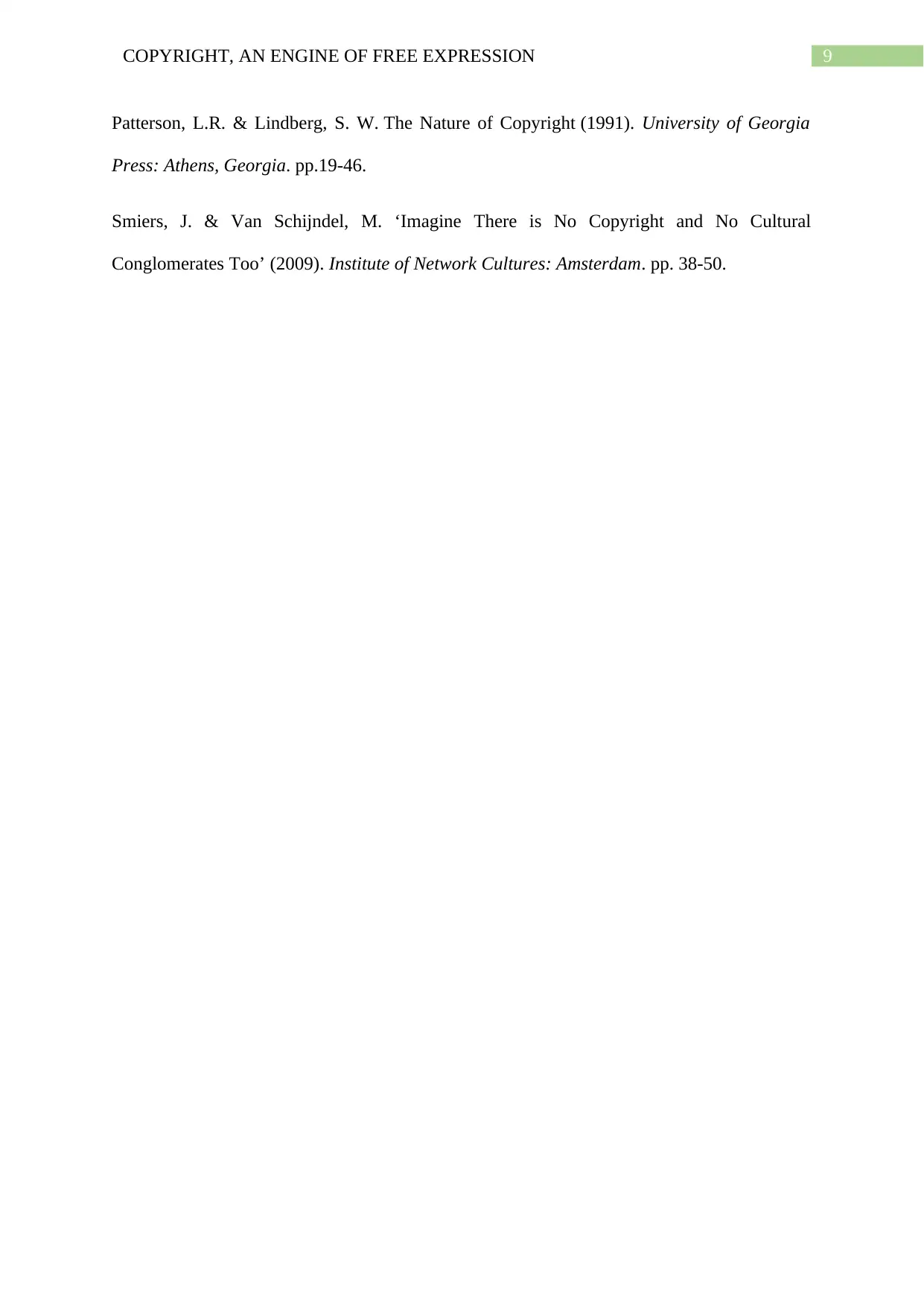
9COPYRIGHT, AN ENGINE OF FREE EXPRESSION
Patterson, L.R. & Lindberg, S. W. The Nature of Copyright (1991). University of Georgia
Press: Athens, Georgia. pp.19-46.
Smiers, J. & Van Schijndel, M. ‘Imagine There is No Copyright and No Cultural
Conglomerates Too’ (2009). Institute of Network Cultures: Amsterdam. pp. 38-50.
Patterson, L.R. & Lindberg, S. W. The Nature of Copyright (1991). University of Georgia
Press: Athens, Georgia. pp.19-46.
Smiers, J. & Van Schijndel, M. ‘Imagine There is No Copyright and No Cultural
Conglomerates Too’ (2009). Institute of Network Cultures: Amsterdam. pp. 38-50.
1 out of 10
Related Documents
Your All-in-One AI-Powered Toolkit for Academic Success.
+13062052269
info@desklib.com
Available 24*7 on WhatsApp / Email
![[object Object]](/_next/static/media/star-bottom.7253800d.svg)
Unlock your academic potential
Copyright © 2020–2025 A2Z Services. All Rights Reserved. Developed and managed by ZUCOL.





